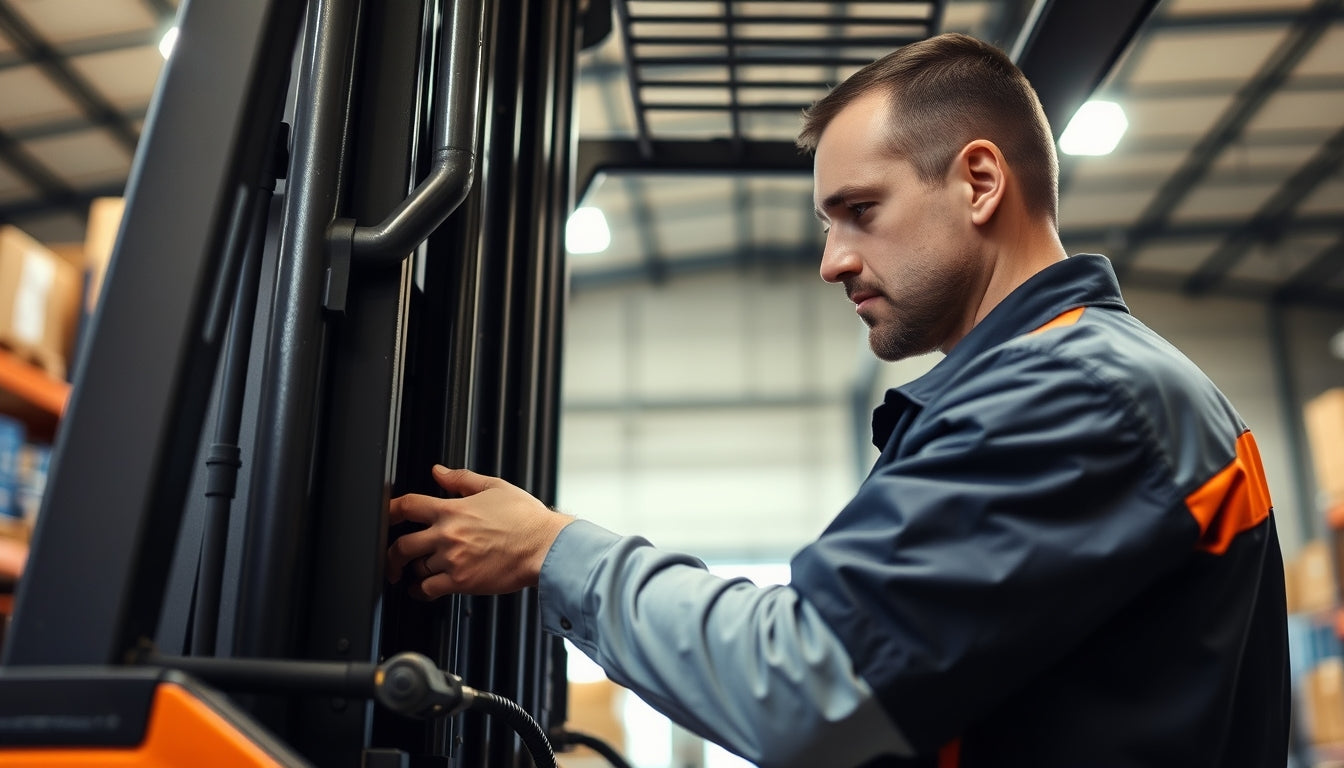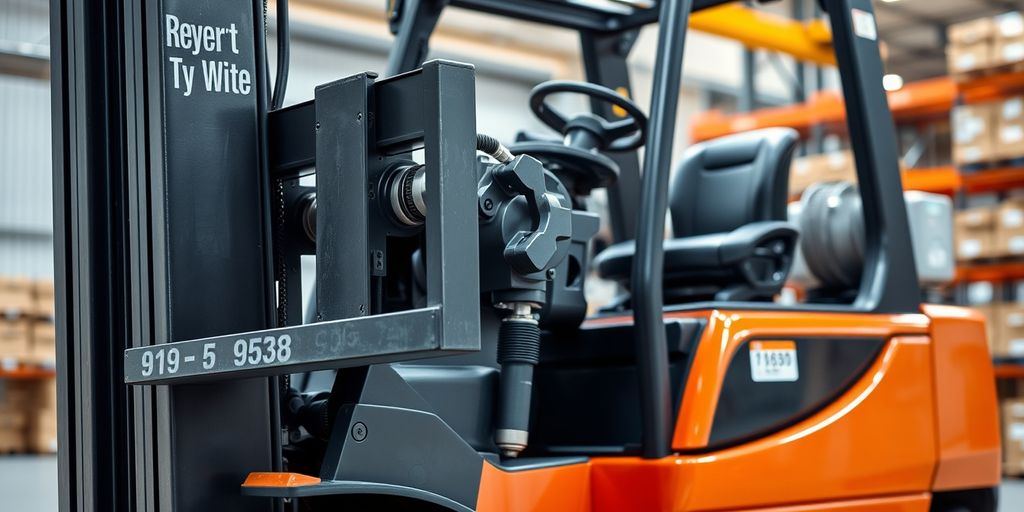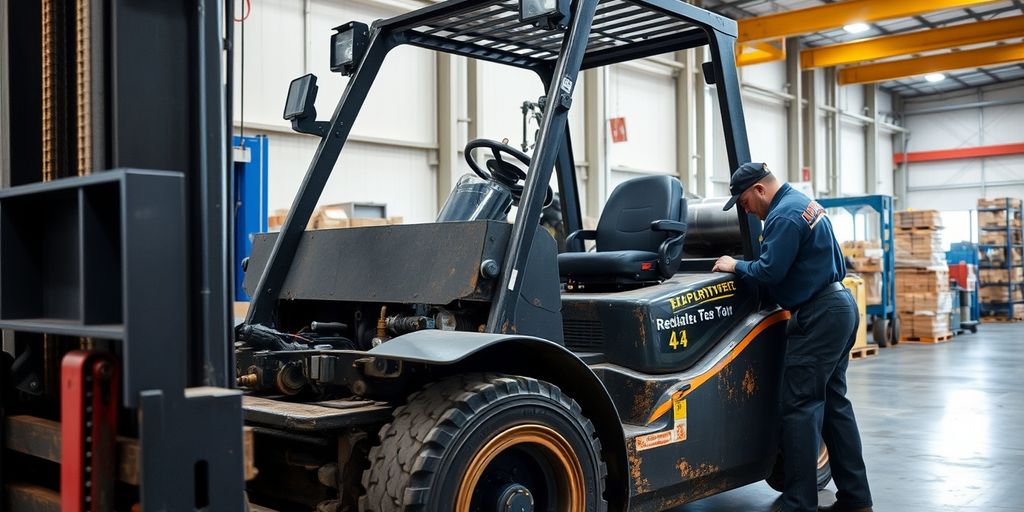Cuándo reemplazar las piezas del montacargas: una guía para mantener su equipo en óptimas condiciones — overview
Las carretillas elevadoras son esenciales para muchas empresas, pero mantenerlas en buen estado es fundamental. Saber cuándo reemplazar las piezas puede ahorrarle tiempo y dinero. Esta guía lo ayudará a comprender las señales de que es necesario reemplazar las piezas, cómo inspeccionarlas y consejos para el mantenimiento preventivo. Además, discutiremos la importancia de elegir piezas de calidad y la capacitación adecuada del operador.
Conclusiones clave
- Revise periódicamente su montacargas en busca de ruidos y vibraciones inusuales para detectar problemas a tiempo.
- Comprenda la vida útil de piezas críticas como horquillas, sistemas hidráulicos y frenos.
- Utilice listas de verificación diarias, semanales y mensuales para inspeccionar su montacargas de manera efectiva.
- El mantenimiento preventivo, como la lubricación regular y el reemplazo de líquidos, puede extender la vida útil de su montacargas.
- La capacitación adecuada del operador es esencial para mantener la seguridad y eficiencia del montacargas.
Señales de que las piezas de su montacargas necesitan ser reemplazadas
Mantener su carretilla elevadora en óptimas condiciones es fundamental para la seguridad y la eficiencia . A continuación, se muestran algunas señales que indican que es hora de reemplazar ciertas piezas de su carretilla elevadora.
Piezas críticas del montacargas y su vida útil

Mantener su montacargas en óptimas condiciones significa saber cuándo reemplazar sus piezas críticas. Aquí hay una guía de los componentes clave y su vida útil esperada.
Tenedores y Tinas
Las horquillas y los dientes son las partes más visibles de una carretilla elevadora. Suelen durar entre 3 y 5 años, según el uso. El mantenimiento regular ayuda a evitar reparaciones de la carretilla elevadora y extiende su vida útil. Busque señales de deformación o grietas, que indican que es hora de reemplazarla.
Sistemas Hidráulicos
Los sistemas hidráulicos son fundamentales para levantar y mover cargas. Estos sistemas pueden durar hasta 10 000 horas con el cuidado adecuado. Revise periódicamente si hay fugas y asegúrese de que el fluido hidráulico esté limpio y en el nivel correcto. El mantenimiento programado es crucial para mantener estos sistemas funcionando sin problemas.
Frenos y Neumáticos
Los frenos y los neumáticos son esenciales para la seguridad. Los neumáticos suelen necesitar ser reemplazados cada 2000 a 3000 horas, mientras que los frenos pueden durar hasta 5000 horas. Inspeccione los neumáticos en busca de desgaste y verifique la capacidad de respuesta de los frenos. Las averías frecuentes en estas áreas pueden ser peligrosas y costosas.
Baterías y Componentes Eléctricos
En el caso de las carretillas elevadoras eléctricas, las baterías y los componentes eléctricos son fundamentales. Las baterías suelen durar unos 5 años, pero esto puede variar según el mantenimiento y el uso. Un mantenimiento adecuado es esencial para minimizar el tiempo de inactividad y mejorar la longevidad de la batería. Compruebe periódicamente los niveles de agua de la batería y limpie los terminales para garantizar un rendimiento óptimo.
Cómo inspeccionar eficazmente las piezas de un montacargas

Lista de Verificación Diaria
Realizar comprobaciones diarias es fundamental para garantizar que su carretilla elevadora funcione de manera segura y eficiente. Se debe realizar una inspección previa al turno antes de cada uso . A continuación, se incluye una lista de comprobación sencilla:
- Mire a su alrededor: revise el montacargas en busca de daños, fugas o piezas sueltas. Presta especial atención al mástil y a los neumáticos.
- Revisión de fluidos: Inspeccione los niveles de aceite del motor, líquido de transmisión, líquido de frenos y líquido hidráulico. Rellénelos si es necesario.
- Verificación de la batería: asegúrese de que los terminales de la batería estén limpios y apretados. Verifique que la batería se esté cargando correctamente.
- Revisión de frenos: Pruebe tanto el freno de estacionamiento como el de servicio. Escuche cualquier ruido inusual.
- Luces y bocina: Pruebe todas las luces y la bocina para asegurarse de que estén funcionando.
- Dirección: gire el volante para asegurarse de que se mueva suavemente. Busque fugas.
- Horquillas y accesorios: Mida la altura de las horquillas y compruebe si hay algún daño.
- Asiento y cinturón de seguridad: ajuste el asiento para su comodidad y asegúrese de que el cinturón de seguridad funcione.
- Controles e indicadores: verifique que todos los botones e indicadores funcionen correctamente. Busque luces de advertencia.
- Placa de capacidad de carga: asegúrese de que la placa que muestra la capacidad de carga del montacargas esté en su lugar y sea legible.
- Accesorios y accesorios: Verifique que todos los accesorios adicionales estén bien sujetos y funcionen correctamente.
- Botón de parada de emergencia: Pruebe el botón de parada de emergencia para asegurarse de que funcione rápidamente y sea de fácil acceso.
Recuerde: si encuentra algún problema durante la revisión, informe inmediatamente a su jefe o al equipo de mantenimiento. No utilice el montacargas si existen problemas de seguridad.
Controles Semanales y Mensuales
Las inspecciones semanales y mensuales ayudan a detectar problemas que podrían no ser obvios durante las inspecciones diarias. Esto es lo que debe buscar:
Controles Semanales:
- Mire a su alrededor: inspeccione todo el montacargas en busca de piezas sueltas, especialmente el tejadillo protector.
- Revisión de fluidos: Mire debajo del montacargas en busca de fugas y asegúrese de que todos los niveles de fluido sean adecuados.
- Verificación de la batería: vuelva a verificar los terminales de la batería y el estado de carga.
- Revisión de frenos: pruebe el freno de emergencia y escuche si hay sonidos inusuales.
- Luces y bocinas: limpie y pruebe todas las luces y bocinas.
- Dirección: compruebe si hay problemas de dirección y fugas.
- Horquillas y accesorios: Mida las horquillas e inspeccione si hay daños.
Controles Mensuales:
- Sistema hidráulico: Inspeccione las mangueras en busca de daños y asegúrese de que el mástil se mueva suavemente.
- Cables y Cadenas: Lubrique y verifique que estén apretados y rectos.
- Sistema de escape: busque grietas u óxido y verifique las emisiones.
- Extensión del respaldo de carga: asegúrese de que esté correctamente sujeta y sin daños.
- Gobernador y acelerador: verifique la configuración del control de velocidad y el funcionamiento del pedal.
- Asiento y cinturón de seguridad: ajuste e inspeccione si hay desgaste.
Uso de herramientas de diagnóstico
Las carretillas elevadoras modernas suelen venir con herramientas de diagnóstico que pueden ayudar a identificar problemas antes de que se conviertan en problemas graves. Estas herramientas pueden comprobar varios sistemas, incluidos el motor, el sistema hidráulico y los componentes eléctricos. Compruebe los cables y conectores con regularidad para asegurarse de que todo esté en buenas condiciones.
Servicios de Inspección Profesional
Si bien las inspecciones diarias, semanales y mensuales son esenciales, las inspecciones profesionales brindan una capa adicional de seguridad. Los expertos pueden detectar problemas que podrían pasarse por alto durante las inspecciones de rutina. Se debe realizar una inspección profesional anualmente para garantizar que su carretilla elevadora esté en óptimas condiciones. También pueden realizar pruebas de carga e inspecciones exhaustivas de componentes críticos como los frenos y los neumáticos.
Consejos de mantenimiento preventivo para montacargas
Mantener su carretilla elevadora en óptimas condiciones requiere un mantenimiento preventivo regular. A continuación, se ofrecen algunos consejos esenciales para garantizar que su equipo funcione de manera eficiente y sin problemas.
Lubricación Regular
La lubricación es fundamental para el buen funcionamiento de su carretilla elevadora. Lubrique periódicamente todas las piezas móviles, incluido el mástil, las cadenas y los engranajes. Esto ayuda a reducir la fricción y el desgaste, lo que prolonga la vida útil de su equipo.
Reemplazos de fluidos oportunos
Los líquidos, como el aceite hidráulico, el aceite del motor y el refrigerante, deben reemplazarse periódicamente. Verifique los niveles de líquido con frecuencia y rellénelos según sea necesario. Los reemplazos oportunos de líquidos evitan el sobrecalentamiento y garantizan un rendimiento óptimo.
Limpieza y Almacenamiento Adecuados
Mantenga limpio su montacargas para evitar la acumulación de suciedad y escombros, que pueden causar daños con el tiempo. Guarde el montacargas en un área seca y protegida para protegerlo de los elementos. Las prácticas adecuadas de limpieza y almacenamiento ayudan a mantener el estado y la funcionalidad del montacargas.
Mantenimiento Profesional Programado
Si bien los controles diarios y semanales son importantes, no se debe pasar por alto el mantenimiento profesional. Programe inspecciones periódicas realizadas por técnicos certificados para identificar y abordar cualquier problema potencial antes de que se convierta en un problema importante. Esto garantiza que su montacargas permanezca en excelentes condiciones de funcionamiento.
El mantenimiento preventivo juega un papel importante para mantener sus montacargas funcionando de manera eficiente. Consiste en controles y ajustes periódicos para garantizar que todos los componentes estén en buen estado de funcionamiento.
Eligiendo Piezas de Repuesto de Calidad
Piezas OEM vs. Piezas de Mercado Secundario
Cuando se trata de reemplazar piezas de montacargas, tiene dos opciones principales: piezas OEM (fabricante de equipos originales) y piezas de repuesto. Las piezas OEM están fabricadas por la misma empresa que construyó su montacargas, lo que garantiza un ajuste perfecto y un rendimiento confiable. Por otro lado, las piezas de recambio son producidas por terceros fabricantes y su calidad puede variar. Si bien pueden ser más baratos, es posible que no siempre cumplan con los mismos estándares que las piezas OEM.
Garantizar la compatibilidad
Antes de comprar cualquier pieza de repuesto, es fundamental asegurarse de que sea compatible con su modelo específico de montacargas. El uso de piezas que no encajan correctamente puede provocar más daños y reparaciones costosas. Siempre verifique los números de pieza y consulte el manual de su montacargas o a un profesional para confirmar la compatibilidad.
Evaluando la reputación del proveedor
No todos los proveedores son iguales. Es importante comprar piezas de proveedores acreditados que tengan un historial de ofrecer productos de alta calidad. Busque reseñas y testimonios de otros clientes para evaluar la confiabilidad del proveedor. Un buen proveedor ofrecerá garantías y tendrá una política de devolución en caso de que las piezas no cumplan con sus expectativas.
Consideraciones de Costo vs. Calidad
Si bien puede resultar tentador optar por la opción más barata, es esencial equilibrar el coste y la calidad. Las piezas de alta calidad pueden ser más caras al principio, pero pueden ahorrarle dinero a largo plazo al reducir la frecuencia de los reemplazos y minimizar el tiempo de inactividad. Invertir en piezas de calidad garantiza que su montacargas funcione de manera eficiente y segura.
El papel de la formación de operadores en el mantenimiento de montacargas

Importancia del Manejo Adecuado
El manejo adecuado de las carretillas elevadoras por parte de los operadores es crucial para mantener el equipo en óptimas condiciones. Cuando los operadores están bien capacitados, pueden identificar y abordar problemas menores antes de que se conviertan en problemas mayores. Esto no solo garantiza la seguridad de los operadores sino que también extiende la vida útil de los montacargas.
Programas de Capacitación y Certificaciones
Es fundamental invertir en programas de capacitación integrales para operadores de carretillas elevadoras. Estos programas deben cubrir tanto los aspectos operativos como los requisitos de mantenimiento de las carretillas elevadoras. Muchas instalaciones ofrecen cursos de capacitación personalizados diseñados en torno a equipos específicos, lo que garantiza que se cumplan todas las normas de OSHA . Esto ayuda a los operadores a comprender la importancia del mantenimiento regular y cómo realizar controles básicos.
Mantenimiento diario por operadores
Los operadores deben estar capacitados para realizar tareas de mantenimiento diarias. Esto incluye verificar los niveles de líquidos, inspeccionar los neumáticos y garantizar que todas las funciones de seguridad funcionen correctamente. Al realizar estas comprobaciones diarias, los operadores pueden ayudar a prevenir averías inesperadas y mantener la eficiencia de las carretillas elevadoras.
Informar y abordar problemas con prontitud
Es vital alentar a los operadores a informar cualquier problema de inmediato. Una respuesta rápida a las necesidades de mantenimiento puede evitar que problemas menores se conviertan en reparaciones costosas. Los operadores deben conocer los canales adecuados para informar problemas y deben sentirse capacitados para hacerlo sin dudarlo.
Capacitar a sus operadores para que aprendan sobre el servicio regular de montacargas lo ayudará a mantener sus montacargas funcionando a su máxima capacidad, para que pueda continuar brindando resultados exitosos.
Análisis Costo-Beneficio del Mantenimiento de Montacargas
Cálculo de Costos de Mantenimiento
Para comprender el costo real de mantenimiento de sus montacargas, debe recopilar algunos datos clave. Esto incluye el costo de las piezas, la mano de obra y cualquier gasto adicional. Una vez que tenga estos números, puede usar herramientas como una calculadora gratuita de mantenimiento de montacargas para obtener una estimación aproximada. Recuerde, si sus costos de mantenimiento comienzan a acercarse a los $4 por hora, podría ser el momento de considerar comprar un nuevo montacargas.
Impacto en la Eficiencia Operativa
El mantenimiento regular puede mejorar significativamente el rendimiento de su montacargas. Los montacargas bien mantenidos experimentan menos averías, lo que significa menos tiempo de inactividad y más productividad. Esto no sólo mantiene sus operaciones funcionando sin problemas, sino que también ayuda a cumplir los objetivos de producción de manera consistente.
Ahorros a largo plazo
Invertir en mantenimiento regular puede generar ahorros sustanciales a largo plazo. Al detectar los pequeños problemas a tiempo, puede evitar que se conviertan en reparaciones importantes y costosas. Además, un montacargas bien mantenido tiene una vida útil más larga, lo que le brinda más valor por su inversión con el tiempo.
Las inspecciones periódicas de los montacargas son esenciales para la seguridad, el rendimiento y el ahorro de costos. Ayudan a identificar componentes desgastados, evitar reparaciones importantes y mejorar la productividad.
Evitando el tiempo de inactividad no planificado
El tiempo de inactividad no planificado puede ser un revés importante para cualquier operación. Si realiza un mantenimiento regular, podrá minimizar el riesgo de averías inesperadas. Esto garantiza que sus montacargas estén siempre listos para funcionar cuando sea necesario, manteniendo su negocio funcionando de manera eficiente.
- Costos más bajos : el mantenimiento preventivo reduce la necesidad de reparaciones frecuentes y disminuye el riesgo de tiempos de inactividad costosos.
- Vida útil mejorada del equipo: Un mantenimiento constante significa que los componentes internos permanecen en funcionamiento por más tiempo, lo que reduce la necesidad de reemplazos.
- Productividad mejorada: con menos interrupciones, sus operaciones pueden continuar sin problemas y cumplir los objetivos de producción sin contratiempos.
Conclusión
En resumen, mantener las piezas de su montacargas en buenas condiciones es clave para asegurarse de que su equipo funcione bien y dure mucho tiempo. Las inspecciones y el mantenimiento periódicos pueden evitar grandes problemas y mantener su montacargas funcionando sin problemas. Al prestar atención a las señales de que es necesario reemplazar las piezas, puede evitar reparaciones costosas y tiempos de inactividad. Recuerde, un montacargas en buen estado no sólo es más seguro sino también más eficiente. Por lo tanto, tómate el tiempo para cuidar tu equipo y él se encargará de tu negocio.
Preguntas frecuentes
¿Por qué es importante reemplazar periódicamente las piezas del montacargas?
Reemplazar las piezas del montacargas con regularidad es crucial para mantener el equipo funcionando de manera segura y eficiente. Ayuda a prevenir accidentes, reduce los costos de mantenimiento y garantiza el cumplimiento de las normas de seguridad.
¿Cómo puedo saber si es necesario reemplazar una pieza del montacargas?
Las señales de que una pieza del montacargas necesita ser reemplazada incluyen ruidos inusuales, disminución del rendimiento, desgaste visible y averías frecuentes. Las inspecciones periódicas pueden ayudar a detectar estos problemas a tiempo.
¿Cuáles son algunas piezas críticas de montacargas que tienen una vida útil específica?
Las piezas clave de los montacargas con una vida útil específica incluyen horquillas y púas, sistemas hidráulicos, frenos, neumáticos y baterías. Conocer esta vida útil ayuda a planificar reemplazos oportunos.
¿Con qué frecuencia debo inspeccionar las piezas de mi montacargas?
Las piezas del montacargas deben inspeccionarse diariamente, con controles más exhaustivos semanal y mensualmente. El uso de herramientas de diagnóstico y servicios de inspección profesionales puede garantizar que no se pase nada por alto.
¿Cuál es la diferencia entre piezas OEM y de posventa para montacargas?
Las piezas OEM (fabricante de equipos originales) son fabricadas por el fabricante del montacargas y garantizan una compatibilidad perfecta, mientras que las piezas de repuesto son fabricadas por otras empresas y pueden variar en calidad y ajuste.
¿Cómo afecta la formación del operador al mantenimiento de los montacargas?
La formación adecuada del operador es esencial para el mantenimiento de montacargas. Los operadores capacitados manejan el equipo correctamente, realizan tareas de mantenimiento diarias e informan los problemas con prontitud, lo que ayuda a extender la vida útil del montacargas.




Deja un comentario
Este sitio está protegido por hCaptcha y se aplican la Política de privacidad de hCaptcha y los Términos del servicio.